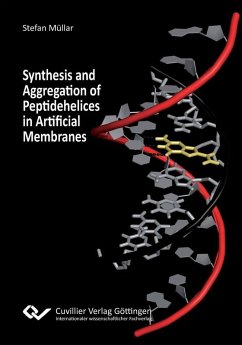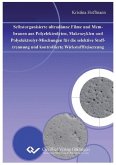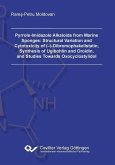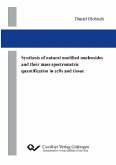The function of membrane proteins is mainly dependend on their aggregational behavior. Some are active as monomers, whereas others need to assemble into oligomeric states.[1] In this context, molecular recognition, which is realized within the membrane and in the adjacent water layer, is crucial to achieve a specific assembly. In order to establish a well defined model system to study assembly processes in membranes, a recently reported D,Lalternating double helical hairpin construct in structural analogy to the natural antibiotic gramicidin A was utilized.[2,3] Recogntion at the membrane/water interface was addressed via met al complex formation as well as duplex formation of a short PNA sequence. To achieve recognition within the bilayer, nucleobases or polar amino acid residues, respectively, were introduced in the center of the hairpin TMD. Additionally, fluorophores were attached applying an orthogonal protecting group strategy. The functionalized TMDs were reconstituted in large unilamellar vesicles (LUVs). The in membrane pore formation by adopting 5.6 double helices was investigated using CD spectroscopy and the dynamic aggregation process was determined using fluorescence probes for Fluorescence Resonance Energy Transfer (FRET). For orientational studies as well as distance measurements of membrane incorporated
peptide homodimer structures, spin probes were introduced within the lead structure. These homodimers were incorporated in LUVs and the 5.6 structure was determined via CD analysis. Further investigation will be performed applying EPR measurements.
For the purpose of creating an alternative to the FRET assay, a fluorescence probe directly sensing the micro environment within the PNA recocgnition unit was utilized. As recently reported, vinyl modification of guanine at position 8 provides fluorescent behavior of the nucleobase. To benefit of the fluorescent properties also in PNA oligomers, the 8 vinylguanine PNA building block was synthesized. Incorporation into PNA oligomers via Fmoc solid phase peptide synthesis allowed the differentiation between hybridization states of specific double strands with DNA, RNA and PNA as well as quadruplex forming RNA/PNA oligomers based on fluorescence intensity.
Dieser Download kann aus rechtlichen Gründen nur mit Rechnungsadresse in A, B, BG, CY, CZ, D, DK, EW, E, FIN, F, GR, HR, H, IRL, I, LT, L, LR, M, NL, PL, P, R, S, SLO, SK ausgeliefert werden.









